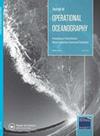NOAA’s Physical Oceanographic Real-Time System (PORTS®)
IF 2.4
3区 地球科学
Q4 METEOROLOGY & ATMOSPHERIC SCIENCES
引用次数: 6
Abstract
ABSTRACT The National Oceanic and Atmospheric Administration’s (NOAA) Physical Oceanographic Real-Time System (PORTS®) is an integrated system of sensors concentrated in seaports that provide accurate and reliable real-time information about environmental conditions. PORTS measures and disseminates observations for water levels, currents, waves, bridge air gap, water temperature, salinity, and meteorological parameters. PORTS was developed and implemented in the early 1990s in response to an accident in Tampa Bay where a vessel struck the Sunshine Skyway Bridge resulting in a substantial loss of life and property. The programme was established as a public-private partnership where the local community funds the establishment and maintenance of the local observing system, and NOAA provides the programme and data management. Today, PORTS has grown to over 30 locations around the country and services over 80% of the tonnage and over 90% of the value of cargo transiting U.S. seaports. A number of economic benefit studies have shown PORTS can reduce accidents by over 50% and significantly increase efficiency. This article examines the evolution of the programme in terms of addressing emerging observational needs, infusing new technology, enhancing products, conducting economic benefit studies, adapting business models, and serving other societal needs.NOAA的物理海洋学实时系统(PORTS®)
美国国家海洋和大气管理局(NOAA)的物理海洋学实时系统(PORTS®)是一个集中在海港的传感器集成系统,可提供准确可靠的环境状况实时信息。PORTS测量并传播水位、水流、波浪、桥梁气隙、水温、盐度和气象参数的观测结果。PORTS是在20世纪90年代初为应对坦帕湾的一起事故而开发和实施的,当时一艘船只撞上了阳光天桥,造成了大量的生命和财产损失。该方案是作为一种公私伙伴关系建立的,由当地社区资助建立和维持当地观测系统,NOAA提供方案和数据管理。今天,PORTS已经发展到全国30多个地点,服务超过80%的吨位和超过90%的货物过境美国海港的价值。多项经济效益研究表明,港口运输系统可将事故减少50%以上,并显著提高效率。本文从解决新出现的观测需求、注入新技术、改进产品、开展经济效益研究、调整商业模式和服务其他社会需求等方面考察了该计划的演变。
本文章由计算机程序翻译,如有差异,请以英文原文为准。
求助全文
约1分钟内获得全文
求助全文
来源期刊
CiteScore
7.50
自引率
9.70%
发文量
8
审稿时长
>12 weeks
期刊介绍:
The Journal of Operational Oceanography will publish papers which examine the role of oceanography in contributing to the fields of: Numerical Weather Prediction; Development of Climatologies; Implications of Ocean Change; Ocean and Climate Forecasting; Ocean Observing Technologies; Eutrophication; Climate Assessment; Shoreline Change; Marine and Sea State Prediction; Model Development and Validation; Coastal Flooding; Reducing Public Health Risks; Short-Range Ocean Forecasting; Forces on Structures; Ocean Policy; Protecting and Restoring Ecosystem health; Controlling and Mitigating Natural Hazards; Safe and Efficient Marine Operations

 求助内容:
求助内容: 应助结果提醒方式:
应助结果提醒方式:


